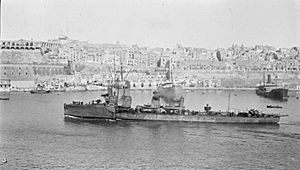HMS Nautilus (1910) facts for kids

Grampus entering Valletta harbour, Malta in 1916
|
|
Quick facts for kids History |
|
|---|---|
| Name | HMS Nautilus |
| Builder | Thames Ironworks and Shipbuilding Company, Leamouth |
| Commissioned | 30 March 1910, as Nautilus |
| Renamed | Grampus, 16 December 1913 |
| Fate | Sold for breaking up, September 1920 |
| General characteristics | |
| Type | Beagle-class destroyer |
| Displacement | 860–940 long tons (874–955 t) |
| Length | 275 ft (84 m) |
| Beam | 27 ft 6 in (8.38 m) |
| Draught | 8 ft 6 in (2.59 m) |
| Installed power | 12,500 hp (9,300 kW) |
| Propulsion | Coal-fired boilers, 2 or 3 shaft steam turbines |
| Speed | 27 knots (50 km/h; 31 mph) |
| Complement | 96 |
| Armament |
|
HMS Nautilus was a special type of Royal Navy warship called a destroyer. She was built to be fast and powerful, helping protect bigger ships and attack enemy vessels. She started her service in 1910. A few years later, her name was changed to HMS Grampus.
Contents
HMS Nautilus was a destroyer built for the Royal Navy. Destroyers are small, fast warships designed to protect larger ships from torpedo attacks and other threats. She was built by the Thames Ironworks and Shipbuilding Company and joined the Navy on March 30, 1910.
A New Name: HMS Grampus
On December 16, 1913, HMS Nautilus got a new name: HMS Grampus. This happened because the Navy wanted to use the name Nautilus for a brand new submarine they were building. That submarine became HMS Nautilus, the first Royal Navy submarine to have that name.
Early Service and World War I
When Nautilus first joined the Navy on September 12, 1911, she became part of the First Destroyer Flotilla. This was a group of destroyers that worked together.
During the First World War, which started in 1914, Grampus played an important role. She was sent to the Dardanelles Campaign against the Ottoman Empire. This was a big military operation in a narrow waterway in Turkey.
Helping During the Dardanelles Campaign
On April 17, 1915, a British submarine called HMS E15 got stuck near Kephaz Point while trying to get through the Dardanelles. Enemy forces fired on her, and her captain and some crew members were killed. The rest were captured.
To stop the enemy from getting their hands on the submarine, the Royal Navy tried to destroy E15. Grampus was part of these efforts, but she couldn't find the submarine.
Later, on August 6, Grampus helped land soldiers from the 11th Battalion, The Manchester Regiment, at Suvla Bay. However, they landed on the wrong part of the beach. The soldiers quickly ran out of drinking water. To help them, on August 8, HMS Grampus cut one of her own water tanks loose. It floated ashore, giving the thirsty soldiers about half a litre of water each.
End of Service
After her service in the war, HMS Grampus was sold. She was bought by a company called Thos. W. Ward on September 21, 1920. They took her to Rainham, Kent to be broken up for scrap metal.

